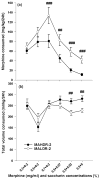Morphine intake and the effects of naltrexone and buprenorphine on the acquisition of methamphetamine intake
- PMID: 24152140
- PMCID: PMC3976242
- DOI: 10.1111/gbb.12100
Morphine intake and the effects of naltrexone and buprenorphine on the acquisition of methamphetamine intake
Abstract
Some common genetic factors appear to influence risk for drug dependence across multiple drugs of abuse. In previous research, mice that were selectively bred for higher amounts of methamphetamine consumption, using a two-bottle choice methamphetamine drinking procedure, were found to be less sensitive to the locomotor stimulant effects of morphine and of the more selective μ-opioid receptor agonist fentanyl, compared to mice that were bred for low methamphetamine consumption. This suggested that μ-opioid receptor-mediated pathways may influence genetic risk for methamphetamine consumption. We hypothesized that these differences in opioid sensitivity would impact opioid intake in the methamphetamine drinking lines and that drugs with μ-opioid receptor activity would impact methamphetamine intake. Consumption of morphine was examined in 2, two-bottle choice studies, one that compared morphine to quinine consumption and another that used a saccharin fading procedure. Next, naltrexone (0, 0.5, 1, 2, 5, 10 and 20 mg/kg), a μ-opioid receptor antagonist, and buprenorphine (0, 1, 2 or 4 mg/kg), a μ-opioid receptor partial agonist, were each examined for their effects on the acquisition of methamphetamine consumption. Low methamphetamine drinking mice consumed more morphine compared to high methamphetamine drinking mice. Naltrexone did not alter methamphetamine consumption in either selected line; however, buprenorphine reduced methamphetamine intake in the high methamphetamine drinking line. These data show that greater sensitivity to opioids is associated with greater opioid intake and warrant further investigation of drugs with μ-opioid receptor-specific agonist activity in genetically determined differences in methamphetamine consumption.
Keywords: addiction; amphetamine; opioid; psychostimulant; quinine; reward; saccharin; selective breeding; two-bottle choice drinking; μ-Opioid receptor.
Published 2013. This article has been contributed to by US Government employees and their work is in the public domain in the USA.
Figures





Similar articles
-
An animal model of differential genetic risk for methamphetamine intake.Front Neurosci. 2015 Sep 23;9:327. doi: 10.3389/fnins.2015.00327. eCollection 2015. Front Neurosci. 2015. PMID: 26441502 Free PMC article. Review.
-
Differential genetic risk for methamphetamine intake confers differential sensitivity to the temperature-altering effects of other addictive drugs.Genes Brain Behav. 2020 Jun;19(5):e12640. doi: 10.1111/gbb.12640. Epub 2020 Jan 15. Genes Brain Behav. 2020. PMID: 31925906 Free PMC article.
-
Opioid sensitivity in mice selectively bred to consume or not consume methamphetamine.Addict Biol. 2014 May;19(3):370-9. doi: 10.1111/adb.12003. Epub 2012 Nov 12. Addict Biol. 2014. PMID: 23145527 Free PMC article.
-
The mu opioid irreversible antagonist beta-funaltrexamine differentiates the discriminative stimulus effects of opioids with high and low efficacy at the mu opioid receptor.Psychopharmacology (Berl). 1998 Nov;140(1):20-8. doi: 10.1007/s002130050734. Psychopharmacology (Berl). 1998. PMID: 9862398
-
Identification of Treatment Targets in a Genetic Mouse Model of Voluntary Methamphetamine Drinking.Int Rev Neurobiol. 2016;126:39-85. doi: 10.1016/bs.irn.2016.02.001. Epub 2016 Mar 7. Int Rev Neurobiol. 2016. PMID: 27055611 Review.
Cited by
-
An animal model of differential genetic risk for methamphetamine intake.Front Neurosci. 2015 Sep 23;9:327. doi: 10.3389/fnins.2015.00327. eCollection 2015. Front Neurosci. 2015. PMID: 26441502 Free PMC article. Review.
-
Confirmation of a Causal Taar1 Allelic Variant in Addiction-Relevant Methamphetamine Behaviors.Front Psychiatry. 2021 Aug 26;12:725839. doi: 10.3389/fpsyt.2021.725839. eCollection 2021. Front Psychiatry. 2021. PMID: 34512422 Free PMC article.
-
Taar1 gene variants have a causal role in methamphetamine intake and response and interact with Oprm1.Elife. 2019 Jul 9;8:e46472. doi: 10.7554/eLife.46472. Elife. 2019. PMID: 31274109 Free PMC article.
-
Non-genetic factors that influence methamphetamine intake in a genetic model of differential methamphetamine consumption.Psychopharmacology (Berl). 2020 Nov;237(11):3315-3336. doi: 10.1007/s00213-020-05614-9. Epub 2020 Aug 24. Psychopharmacology (Berl). 2020. PMID: 32833064 Free PMC article.
-
Differential genetic risk for methamphetamine intake confers differential sensitivity to the temperature-altering effects of other addictive drugs.Genes Brain Behav. 2020 Jun;19(5):e12640. doi: 10.1111/gbb.12640. Epub 2020 Jan 15. Genes Brain Behav. 2020. PMID: 31925906 Free PMC article.
References
-
- Altshuler HL, Phillips PE, Feinhandler DA. Alteration of ethanol self-administration by naltrexone. Life Sci. 1980;26:679–88. - PubMed
-
- Belknap JK, Crabbe JC, Riggan J, O’toole LA. Voluntary consumption of morphine in 15 inbred mouse strains. Psychopharmacology (Berl) 1993;112:352–8. - PubMed
-
- Belknap JK, Richards SP, O’toole LA, Helms ML, Phillips TJ. Short-term selective breeding as a tool for QTL mapping: ethanol preference drinking in mice. Behav Genet. 1997;27:55–66. - PubMed
-
- Berrettini WH, Alexander R, Ferraro TN, Vogel WH. A study of oral morphine preference in inbred mouse strains. Psychiatr Genet. 1994a;4:81–6. - PubMed
Publication types
MeSH terms
Substances
Grants and funding
LinkOut - more resources
Full Text Sources
Other Literature Sources
Medical
Molecular Biology Databases
Research Materials

